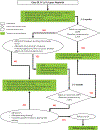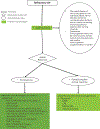Expert Perspective: An Approach to Refractory Lupus Nephritis
- PMID: 35166048
- PMCID: PMC9156543
- DOI: 10.1002/art.42092
Expert Perspective: An Approach to Refractory Lupus Nephritis
Abstract
Systemic lupus erythematosus affects the kidneys in ~50% of all patients, and lupus nephritis (LN) is the most common manifestation of kidney involvement. Despite prompt diagnosis and treatment with aggressive immunosuppression, a significant proportion of LN patients do not respond to treatment and are considered to have refractory LN. Several factors other than drug resistance, such as nonadherence to treatment, undertreatment with conventional drugs, the effects of accumulated chronic damage, and genetic factors, may contribute to a poor response to treatment and should be considered. We define refractory LN as no change in (or worsening of) proteinuria and/or estimated glomerular filtration rate in response to 2 different standard-of-care induction regimens after 4-6 months in patients who are adherent to treatment. For patients who have LN that is truly refractory to standard of care, B cell-targeted therapy, specifically rituximab (RTX), is the most common next step. There is limited evidence available on alternative rescue therapies that may be used when there is no response to RTX. These include anti-CD38, leflunomide, intravenous immunoglobulin, plasma exchange, autologous stem cell transplantation, chimeric antigen receptor T cell therapy, anticomplement therapy, and interleukin-2 therapy.
© 2022 American College of Rheumatology.
Figures



Similar articles
-
Long-term follow-up of autologous peripheral blood hematopoietic stem cell transplantation for refractory lupus nephritis-a series study of 20 patients.Lupus. 2022 Nov;31(13):1586-1594. doi: 10.1177/09612033221126848. Epub 2022 Sep 17. Lupus. 2022. PMID: 36117428
-
Rituximab as add-on therapy in patients with resistant lupus nephritis who have failed induction or maintenance therapy with other agents: A real-world experience from a single center in Mumbai.Lupus. 2024 Jan;33(1):88-95. doi: 10.1177/09612033231219354. Epub 2023 Dec 4. Lupus. 2024. PMID: 38048588
-
Rituximab use as induction therapy for lupus nephritis: a systematic review.Lupus. 2020 Jul;29(8):892-912. doi: 10.1177/0961203320928412. Epub 2020 Jun 2. Lupus. 2020. PMID: 32486934
-
Differences in rituximab use between pediatric rheumatologists and nephrologists for the treatment of refractory lupus nephritis and renal flare in childhood-onset SLE.Pediatr Rheumatol Online J. 2021 Aug 30;19(1):137. doi: 10.1186/s12969-021-00627-w. Pediatr Rheumatol Online J. 2021. PMID: 34461932 Free PMC article.
-
Lupus nephritis and B-cell targeting therapy.Expert Rev Clin Immunol. 2017 Oct;13(10):951-962. doi: 10.1080/1744666X.2017.1366855. Epub 2017 Aug 18. Expert Rev Clin Immunol. 2017. PMID: 28800401 Review.
Cited by
-
[Diagnostic and therapy of lupus nephritis - 2023].Wien Klin Wochenschr. 2023 Aug;135(Suppl 5):675-687. doi: 10.1007/s00508-023-02263-8. Epub 2023 Sep 20. Wien Klin Wochenschr. 2023. PMID: 37728652 Free PMC article. German.
-
Treatment of refractory lupus nephritis using leflunomide: A prospective study.Front Immunol. 2023 Mar 17;14:1133183. doi: 10.3389/fimmu.2023.1133183. eCollection 2023. Front Immunol. 2023. PMID: 37006280 Free PMC article.
-
Application of CD38 monoclonal antibody in kidney disease.Front Immunol. 2024 May 10;15:1382977. doi: 10.3389/fimmu.2024.1382977. eCollection 2024. Front Immunol. 2024. PMID: 38799465 Free PMC article. Review.
-
Systemic Lupus Erythematosus in Children.Indian J Pediatr. 2024 Oct;91(10):1032-1040. doi: 10.1007/s12098-023-04833-0. Epub 2023 Sep 15. Indian J Pediatr. 2024. PMID: 37713101 Review.
-
Management of Lupus Nephritis: New Treatments and Updated Guidelines.Kidney360. 2023 Oct 1;4(10):1503-1511. doi: 10.34067/KID.0000000000000230. Kidney360. 2023. PMID: 37528520 Free PMC article. Review.
References
-
- Parikh SV, Almaani S, Brodsky S, Rovin BH. Update on lupus nephritis: core curriculum 2020. Am J Kidney Dis. 2020;76:265–281. - PubMed
-
- Maroz N, Segal MS. Lupus nephritis and end-stage kidney disease. Am J Med Sci. 2013;346:319–323. - PubMed
-
- Moroni G, Ponticelli C. The multifaceted aspects of refractory lupus nephritis. Expert Rev Clin Immunol. 2015;11:281–8. - PubMed
Publication types
MeSH terms
Substances
Grants and funding
LinkOut - more resources
Full Text Sources
Medical
Research Materials

